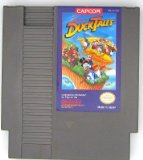Rating of
3.5/5
The First Good Licensed Game
Nelson Schneider - wrote on 03/11/15
Back at the turn of the decade between the 1980s and 1990s, something miraculous happened in the offices of Capcom. Somehow, the company’s licensed game development teams managed to create videogames based on Disney’s animated TV shows that were not absolutely horrible. After coming off the disastrously bad “Mickey Mousecapade,” the quality and success of “DuckTales” at first seemed a fluke, but with a new licensed Disney cartoon game releasing every year between 1989 and 1992, it soon became apparent that Capcom was onto something.
Presentation
For an 8-bit NES game, “DuckTales” looks pretty good. All of the characters and enemies are recognizable for what they’re supposed to be, and the environments look pretty good. However, “DuckTales” runs full-steam into the NES’ sprite limit, which leads to a lot of flickering and slowdown. Oddly enough, the Capcom devs that were working on “DuckTales” must have never seen an episode of the show, but instead worked from the classic “Uncle Scrooge” Disney comic books, as Scrooge’s red topcoat in the game matches what he wore in the comics instead of the blue topcoat he wore in the “DuckTales” TV show.
The soundtrack is definitely the high point of “DuckTales’” presentation. It is naturally limited to chiptunes due to the NES hardware, yet each stage features an incredibly catchy, unique composition.
Story
Scrooge McDuck wants treasure! Scrooge McDuck gathers treasure! Dracula shows up! WTF? I don’t even know what’s going on here.
Gameplay
“DuckTales” is one of the easier 2D platformers of the NES era. Back in 1989, I never managed to complete it because I sucked just that much at games (I did manage to complete “Chip ‘n Dale: Rescue Rangers,” however). Revisiting the game after playing through the remastered version that was released in 2013, I discovered that I was able to complete the entirety of “DuckTales” in an hour with only a couple of deaths.
Scrooge isn’t exactly a combat powerhouse, being an elderly billionaire. He doesn’t really have any attack capabilities outside of using his cane as a pogo-stick and bouncing on enemies’ heads. Scrooge also has a regular jump and a golf-swing with his cane that can send small, stationary objects flying through the air into other stationary objects or enemies. What makes “DuckTales” stand apart from most other NES era platformers is that the controls and mechanics, while fairly simple, are actually decently responsive. Sure, it’s a little clunky to have to hold down+B while in the air to start pogo-jumping, but it’s not a deal breaker.
“DuckTales” also stands out from most other NES era platformers in the fact that the stages are fairly large, somewhat non-linear, and packed with secrets. Just walking around frequently causes gemstones to appear (which increase Scrooge’s wealth and the player’s score), plus there are a number of hidden chests with bonus treasures – there are even two life motes that expand Scrooge’s life meter from 3 hits to 5.
Of course, being one of the best NES era platformers still means the game is an NES era platformer. These games in general do not age particularly well and are usually known for being particularly hostile toward the player… they simply did NOT want to be completed. “DuckTales” may have bucked some of these trends to stand tall among its peers, but it still isn’t perfect: It still rushes the player with an omnipresent timer, it still must be completed in a single sitting, and it still forces the player to start over from the very beginning if they lose all of their lives.
Overall
“DuckTales” manages to hold up well compared to most NES era platformers simply because it is less fiercely anti-player than most of them. No 8-bit games have aged nearly as well as their 16-bit successors, but “DuckTales” still stands among the best NES games simply for its relative playability and the quality of the design poured into the stages. Capcom’s secret in creating good licensed games was to simply create a good game, then paint a veneer of the licensed property on top of it.
Presentation: 4/5
Story: 1/5
Gameplay: 3.5/5
Overall (not an average): 3.5/5




